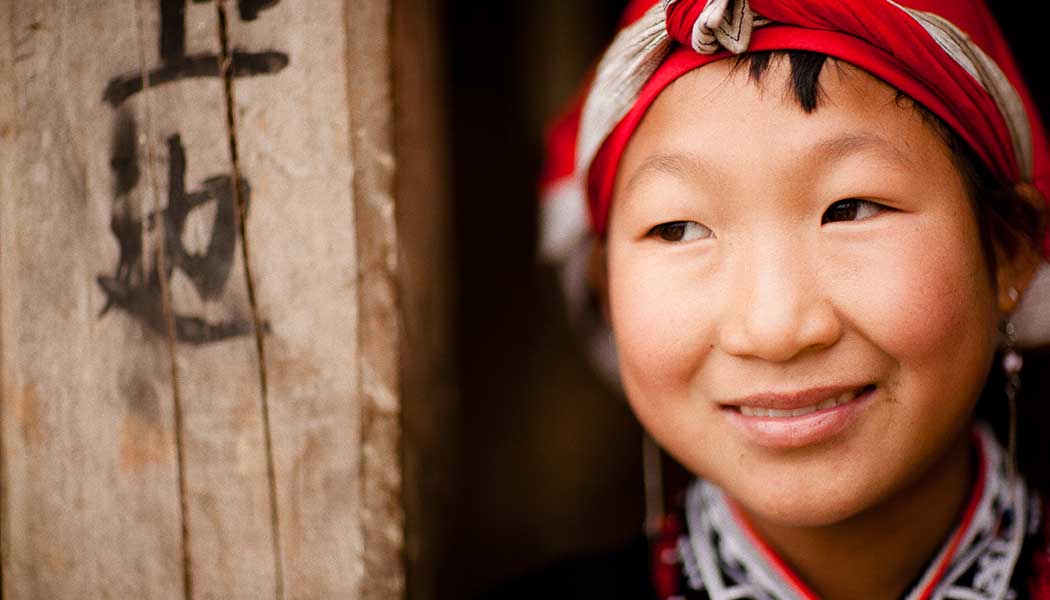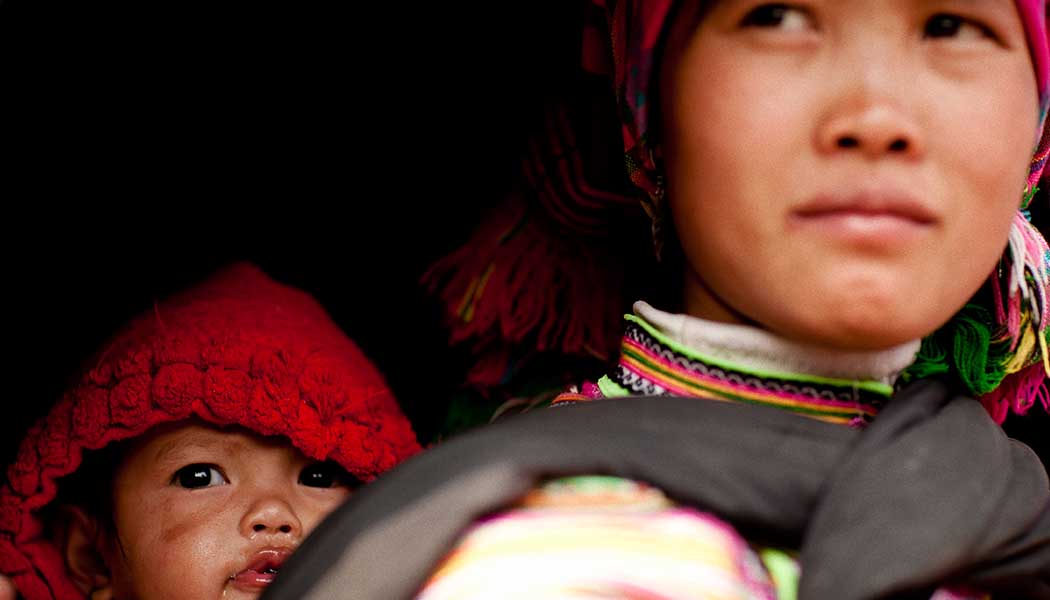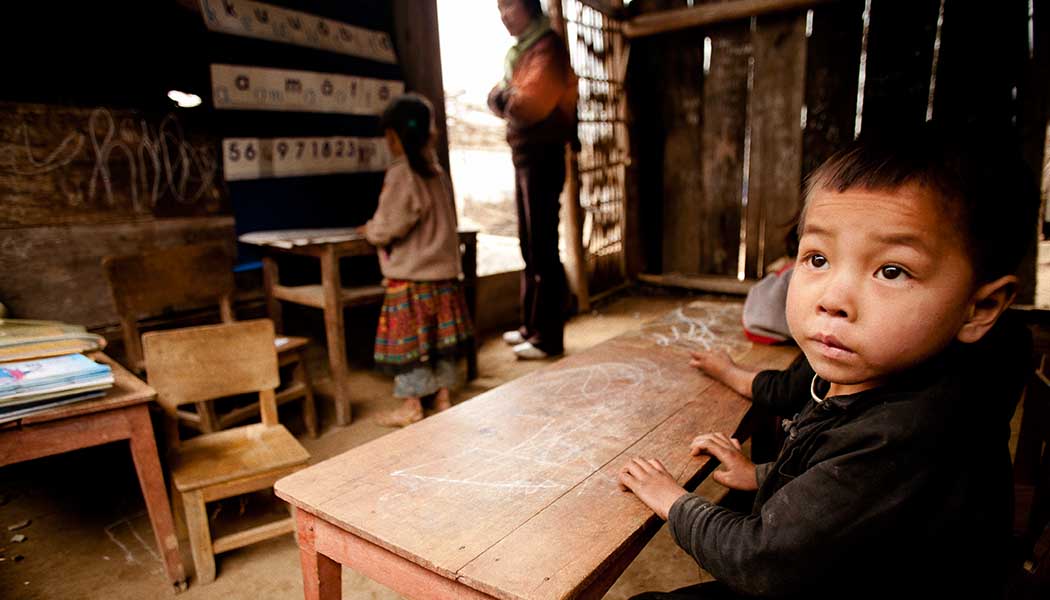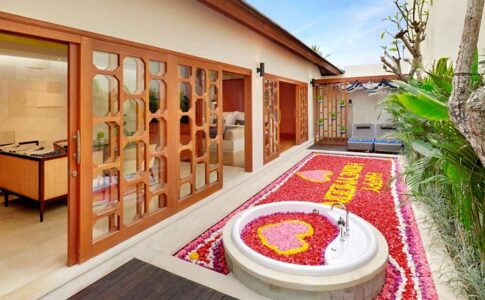The traditional hill tribes of Vietnam – a richly diverse population of different beliefs and customs – defy the challenges of homogenous cliche. Text: Joe Yogerst. Photography: D.Hump.
IT was one of the strangest things I have come across anywhere on the planet, hundreds of people arrayed along a muddy river searching for gold.
Not with anything faintly high-tech but rather old-fashioned metal pans, wooden poles, washboards and sluice boxes; some using nothing more than their hands, like a flashback to California of the 1840s when all of this equipment was originally invented. But in this case on the other side of the Pacific, the northern highlands of Vietnam, not far from the mountain town of Sapa.
The miners – men, women and children – were all Black Thai (Tai), one of a dozen ethnic groups that inhabit these highlands. It looked like arduous work, yet the miners told me it was worth every bead of sweat – much better than laboring in the rice fields. Their average daily find was about a tenth of an ounce, which they could sell to local assayers or the gold shops of Hanoi.
Nearly four decades after unification and more than half a century since the end of French colonial rule, the northern highlands remain much like they were in bygone times … secluded and wildly romantic, infused with an edgy frontier vibe, and still largely devoid of the tourists who have flooded other parts of Vietnam over the past few decades.
For centuries, rugged topography prevented the region from integrating into the mainstream of Vietnamese civilization. Even today, this clenched fist of mountains and steep river valleys – the eastern-most extreme of the Himalayan chain – continues to defy lowland influence. Much of the highlands are still inaccessible except on foot. Roads are better than they used to be but many are in dire need of repair, and washouts are common during the rainy season. It is possible to catch a plane into Sapa and several other mountain outposts (less than an hour from Hanoi as the crow flies), but low clouds, poor visibility and short runways can make it a risky business.
This splendid isolation has also preserved the region’s melting pot: a patchwork of highland tribes that includes the Black and White Thai, Meo and Muong, and four different subgroups of Hmong. Outside of the large market towns and provincial capitals, it can be hard to find someone who speaks fluent Vietnamese. Historically they have very little in common with the people of the flatlands and, instead, look across the nearby border for their cultural roots, to the hill tribe regions of Laos, northern Thailand and southern China.
Traveling through the region is a modern Canterbury Tales of strange encounters with people along the roads and rivers, full of surprises and with little indication what might be around the next bend. In a thatched-roof village called Bon Phang, on the other side of Hoang Lien National Park from Sapa, I came across an itinerant magician entertaining hundreds of people in the town square. Like the gold seekers who I had come across earlier, most of them were Black Thai, instantly identifiable from the flamboyant clothing and jewellery worn by the women. Black ankle-length skirts and brilliant blouses in shades of pink, lavender and aquamarine with big silver buttons shaped like butterflies. Their raven hair in buns, concealed by black scarves, hemmed in the intricate embroidery for which all of the highland tribes are known.
Driving an isolated stretch between Sapa and another big highland town called Lai Chau, we came across about a dozen men with guns and assumed they were brigands.
And why not?
There were certainly bandits here in the 1990s and the region still has a reputation for lawlessness. The armed men moved swiftly through the landscape as if chasing something, intersecting the road just ahead of our jeep. Heart-in-throat time, your mind racing with thoughts of how you’re going to handle the impending confrontation. But it turns out they’re Hmong stalking wild boar with primitive flintlock rifles and hunting dogs.
Down in the valley of the Nam Muc River, along the side of a road, came another unexpected encounter, this time with a fresh grave. And not just any grave, but the elaborate burial place of a young White Thai woman who died from natural causes just a few days before. Towering above the grave was a bamboo scaffold – around 15 metres high; strung with red, white and blue streamers and the dead woman’s clothes. Over the grave itself was a tiny wooden house on stilts, a scale model of a typical White Thai dwelling. Inside the hut were her body and various items she would need in the afterlife: food items, mosquito net, cotton quilt, woven floor mat and a tiny round chair for her ghost to sit on. Burning joss sticks were planted in the ground around this “grave house” and nearby was a small wooden altar adorned with animal bones and cow horns.
Animism continues to thrive through much of the highlands. In Tong Nho, another Black Thai village, I met an 85-year-old shaman with a dusty leather valise at his side. Reaching inside he extracted an ancient book wrapped in plastic to protect it from the elements.
“This is the Black Thai almanac,” said the old man, “it goes back four or five generations in my family.”
Inside were colourful zodiac charts, numerical tables and other means by which he guided the everyday life of Tong Nho village.
With me looking over his shoulder, the shaman flipped through the almanac, explaining the significance of each page.
“These pictures show us the good and bad days to start building a new house, get married, plant crops, and so on. Everything is determined by 60-day cycles that are repeated six times each lunar year. The book also has instructions on how to position your house. If the door is facing the dragon’s head – as in this drawing – then the inhabitants will be gobbled up. Doors should always face the dragon’s body. We still use this book now. The village always asks my advice for new houses, weddings parties, and so on.”
Using the almanac as his celestial guide, the old man also practiced astrology and told fortunes.
“Becoming a shaman doesn’t depend on your wealth or your family,” he explained.
His eldest son, translating from the Black Thai language into Vietnamese, which was then converted into English for my benefit:
“It depends on your knowledge.”
I asked him what would happen to the book and its store of ancient knowledge after his death.
“Anyone in my family who wants to learn or view this book can do so. And if not my family, someone else from the village will be trained to read this book, to be my successor.”
Despite its isolation, the region played a pivotal role in French Indochina. Owing to its pleasant highland climate, Sapa evolved from a colonial military outpost on the edge of empire into a fashionable “hill station” frequented by Hanoi’s elite. Most of the elegant colonial buildings were destroyed during the revolution of the 1950s and the town sank into decades of obscurity. But it was that mild climate – in tandem with the awesome scenery and hill tribe cultures – that resurrected the town’s fortunes around 20 years ago, transforming it into the tourism and adventure travel center of the highlands.
Several other places in the highlands also trace their roots to colonial times. Perched on a bleak hillside overlooking the town of Son La is an old French penitentiary. Built just after the turn of the 20th century, the prison was the scene of numerous guillotine executions, most of them Black Thai warriors who resisted France’s rule. Within its first decade, the prison also witnessed a least one massive jailbreak and a Bastille-like storming of its bastions by Black Thai rebels who summarily dispatched the French commandant.
The most notorious phase of the prison’s history began in the 1930s when Son La became something of an inland Devil’s Island for political prisoners from all around Vietnam. In a way, one established credibility as a Communist cadre by doing time at Son La. Many of the post-independence leaders were imprisoned there at one time or another. And many never left. Beneath the prison kitchen are underground cells that could be flooded with water in a matter of minutes. Prisoners were kept there for weeks at a time, submerged in chin-high water, trying to stay awake, stay afloat, to stay alive. Most of them didn’t.
Ghosts of the highland past also linger in Dien Bien Phu. The lush valley holds a special place in the French psyche akin to Agincourt or Waterloo – a name that’s instantly emblematic of French defeat and surrender. The fierce battle that played out there in 1954 spelled not only the end of French dominion in Vietnam but also the start of geopolitical trends that would eventually draw America into war in Indochina. But that was long ago, a different era, before most of today’s Vietnamese were even born. Tanks and mortars have given way to spades and plows. Nowadays, Dien Bien Phu is just another mountain valley where people get on with the future rather than dwell on the past.
Locals are more apt to talk these days about the “First Battle of Dien Bien Phu” – something I had never ever heard about till my visit. Three hundred years ago, the valley was a central node in the lucrative caravan network linking Thailand, southern China and the Red River Valley, a sort of miniature Samarkand of the hills. Its strategic and economic value was manifest.
“This valley was very crowded at the time,” a member of the local district committee told me.
“Trade was booming. They traded silver, clothes, agricultural and forest products. They mined silver in this area. And they grew opium too!”
Such wealth was bound to draw the attention of outsiders, like the Chinese warriors who marched over the mountains in the mid-18th century to seize Dien Bien Phu. According to legend, the invaders rounded up hundreds of local children, drowned them and showed the bleached bones to their grieving parents as a warning that they should never try to rebel. It took the better part of a year, but the Black Thai whipped themselves into fighting shape and confronted the Chinese. The final victory came in 1758 through an ingenious strategy called the “Goat Defense”. Under the cover of darkness, the rebels gathered 300 goats in the hills surrounding the valley. Lighted candles were fixed to the animals’ horns and they were herded down the mountain in clear view of the Chinese army camp. As was intended, the enemy looked up, saw this mass of quivering light and presumed it was massive reinforcements arriving. The invaders fled in panic, never to return.
A fortress constructed after the battle to guard against future incursions lies near the center of the valley, crumbling ramparts and moats that form the outer shell of Ban Phu Citadel. Wandering around inside the walls, I came across the tomb of the general who devised the goat defense next to a tranquil pond and a simple mud-brick shrine. Offerings of bananas, limes and sesame cakes had been left on the mud doorstep, and inside, above the altar, was a painting of the general on a white steed. An almost forgotten bit of history in a place that time seems to have left time behind.
So much of the highlands have that same bygone vibe. At some point, the 21st century will arrive and the rich, diverse hill tribe cultures will dilute or even vanish. But for the time being, old ways and means linger in the mountains and valleys around Sapa.








































